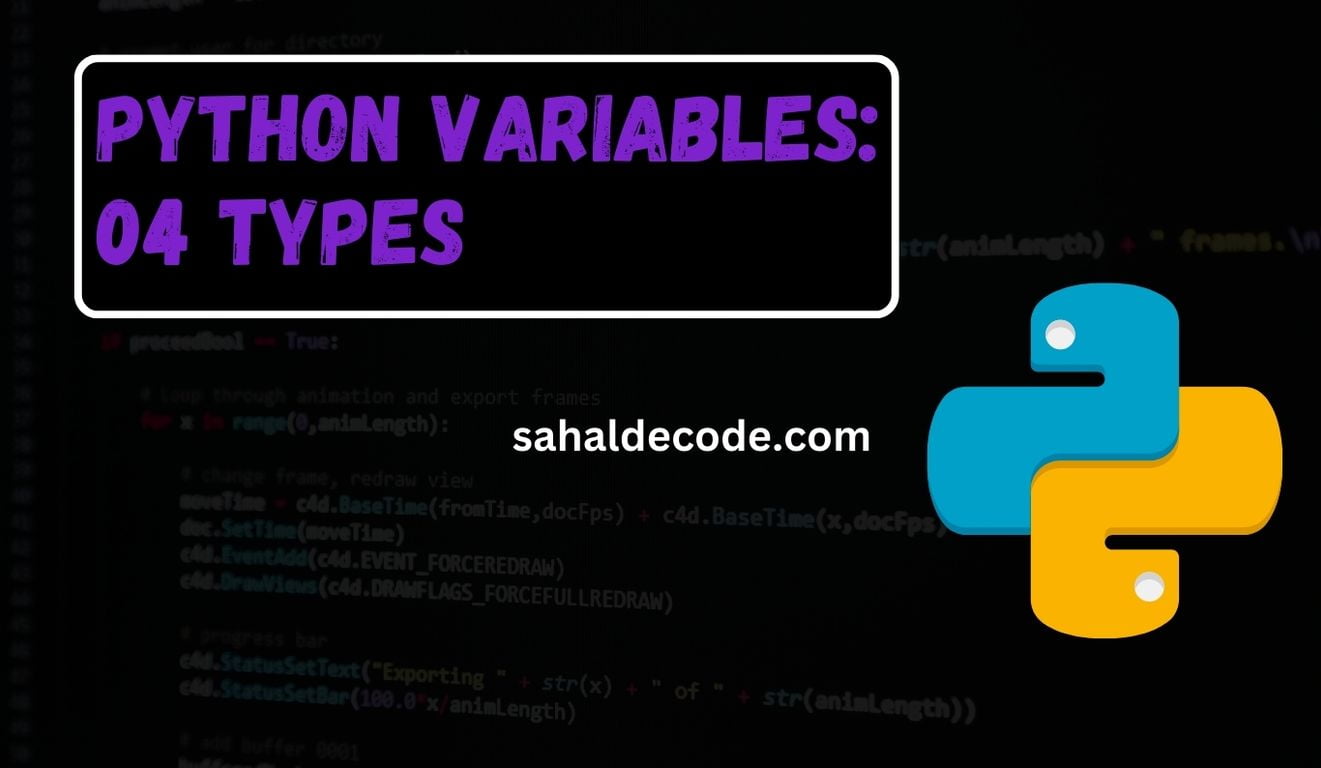Introduction
In the exciting world of programming, Python variables play a vital role in storing and managing data. Whether you’re just starting your coding journey or are already an enthusiast, understanding Python variables is a fundamental step. In this article, we’ll delve into the concept of Python variables, provide illustrative examples, and guide you through their usage.
What Are Python Variables?
At its core, a variable in Python is like a container that holds information. This information can be of different types, such as numbers, text, or more complex data structures. Variables are crucial because they enable us to store and manipulate data, making our programs dynamic and adaptable.
04 Types Of Python Variables:
- Variable Names
- Assign Multiple Values
- Output Variables
- Global Variables
Examples of Python Variables
Let’s dive into some examples to better understand Python variables. Imagine you’re creating a simple program that calculates the area of a rectangle:
# Length and width of the rectangle
length = 5
width = 3
# Calculate the area
area = length * width
# Print the result
print("The area of the rectangle is:", area)
In this example, length, width, and area are variables. length and width store the dimensions of the rectangle, while area holds the calculated result.
Here’s another example using text data:
# Your name
name = "Alice"
# Greeting message
greeting = "Hello, " + name + "! How are you today?"
# Print the greeting
print(greeting)In this case, name and greeting are variables. name stores the text “Alice,” and greeting combines the name with a greeting message.
Using Variables in Python
Variables can be used to store data temporarily or to perform calculations. They provide flexibility to your programs and make them more interactive. Let’s consider a scenario where you want to convert temperatures from Celsius to Fahrenheit:
# Temperature in Celsius
celsius_temp = 25
# Conversion formula
fahrenheit_temp = (celsius_temp * 9/5) + 32
# Display the result
print("25°C is equal to", fahrenheit_temp, "°F")Here, celsius_temp holds the input temperature in Celsius, and fahrenheit_temp stores the converted temperature in Fahrenheit.
Variable Names and Best Practices
While creating variable names, it’s important to follow some guidelines:
- Start with a letter (a-z, A-Z) or underscore (_).
- Avoid using reserved words like
if,while, etc. - Use descriptive names to make your code understandable.
Python – Variable Names
Remember that variable names are case-sensitive
Understanding Variable Names in Python Programming
When delving into the realm of programming, one of the foundational concepts you’ll encounter is variable names. Variable names play a pivotal role in coding as they serve as labels for storing and managing data. In this article, we’ll unravel the significance of variable names in Python programming, delve into best practices for naming variables, and illustrate how to choose meaningful and effective names.
Why Are Variable Names Important?
Variable names are more than just arbitrary labels; they are the keys to unlocking clarity and maintainability in your code. Well-chosen variable names make your code self-explanatory, enabling you and other developers to understand its purpose without diving into intricate details.
Consider the following scenario:
a = 5
b = 3
result = a + b
print(result)At first glance, this code might seem straightforward, but as your programs grow in complexity, deciphering the purpose of variables like a, b, and result becomes challenging. Clear and meaningful variable names can transform this code snippet into a readable gem:
first_number = 5
second_number = 3
sum_of_numbers = first_number + second_number
print(sum_of_numbers)With expressive variable names, the code tells a story that’s easy to follow, even for someone who didn’t write it.
Best Practices for Naming Variables
- Be Descriptive: Choose names that provide insight into the variable’s purpose. Instead of
xortemp, opt for names likeuser_ageortemperature_reading. - Use Camel Case: In Python, it’s common to use a camel case for variable names. Start with a lowercase letter and capitalize the first letter of subsequent words, like
wordCountorstudentAge. - Avoid Reserved Words: Don’t use words that Python has reserved for specific purposes, such as
if,while,for, and others. - Keep It Concise: While being descriptive is crucial, excessively long names can clutter your code. Strive for a balance between clarity and brevity.
- Use Underscores for Readability: For multi-word variable names, consider using underscores to enhance readability, like
total_amountoruser_input. - Follow a Consistent Style: If you’re working on a team or contributing to open-source projects, adhere to the project’s established naming conventions.
- Avoid Abbreviations: While brevity is important, abbreviations can lead to confusion. It’s better to have a slightly longer name that’s clear than an abbreviation that requires guesswork.
Choosing Effective Variable Names: Examples
Poor Naming:
x = 10
y = 20
z = x + y
#---------
n = 5
lst = [1, 2, 3, 4, 5]
Improved Naming:
first_score = 10
second_score = 20
total_score = first_score + second_score
#---------
num_students = 5
student_scores = [1, 2, 3, 4, 5]
Python Variables – Assign Multiple Values
Many Values to Multiple Variables
Python allows you to assign values to multiple variables in one line:
x, y, z = "Orange", "Banana", "Cherry"
print(x)
print(y)
print(z)Note: Make sure the number of variables matches the number of values, or else you will get an error.
One Value to Multiple Variables
And you can assign the same value to multiple variables in one line:
x = y = z = "Orange"
print(x)
print(y)
print(z)Unpack a Collection
If you have a collection of values in a list, tuple, etc. Python allows you to extract the values into variables. This is called unpacking.
#Unpack a list:
fruits = ["apple", "banana", "cherry"]
x, y, z = fruits
print(x)
print(y)
print(z)Learn more about unpacking in our Unpack Tuples Chapter.
Python – Output Variables
The Python print() function is often used to output variables.
x = "Python is awesome"
print(x)In the print() function, you output multiple variables, separated by a comma:
x = "Python"
y = "is"
z = "awesome"
print(x, y, z)You can also use the + operator to output multiple variables:
x = "Python "
y = "is "
z = "awesome"
print(x + y + z)Notice the space character after "Python " and "is ", without them, the result would be “Pythonisawesome”.
Python – Global Variables
What Are Global Variables?
In Python, a global variable is a variable that is defined outside of any function and can be accessed from anywhere within your code, whether it’s inside functions, classes, or modules. Global variables hold data that needs to be shared and used across multiple parts of your program.
Declaring and Accessing Global Variables
Creating a global variable is as simple as assigning a value to it outside of any function. Here’s an example:
# Define a global variable
global_var = 10
# Function that uses the global variable
def use_global_variable():
print("Global variable value:", global_var)
# Call the function
use_global_variable()In this example, the global_var variable is accessible within the use_global_variable function even though it’s defined outside of it.
Modifying Global Variables within Functions
While you can access global variables within functions, modifying them requires extra attention. If you attempt to assign a new value to a global variable within a function without explicitly declaring it as global, Python will treat it as a local variable.
# Define a global variable
global_var = 10
# Function that attempts to modify the global variable
def modify_global_variable():
global_var = 20 # This creates a new local variable
print("Inside function:", global_var)
# Call the function
modify_global_variable()
print("Outside function:", global_var)In this case, the output will be:
Inside function: 20
Outside function: 10To modify a global variable within a function, use the global keyword:
# Define a global variable
global_var = 10
# Function that modifies the global variable
def modify_global_variable():
global global_var
global_var = 20
print("Inside function:", global_var)
# Call the function
modify_global_variable()
print("Outside function:", global_var)Now the output will be:
Inside function: 20
Outside function: 20Best Practices for Using Global Variables
- Limit Their Use: Global variables can make code harder to understand and maintain. Use them only when necessary and consider alternatives like function arguments and return values.
- Avoid Overwriting: Choose descriptive and unique names for global variables to avoid accidentally overwriting them.
- Use Constants: If a global variable should remain constant throughout your program, use uppercase names to indicate it’s a constant value.
- Documentation: Clearly document the purpose and usage of global variables to assist other developers (and your future self) in understanding their role.
Global variables in Python provide a means to share data across different parts of your code. Understanding their behavior, and accessing, and modifying them within functions is crucial to harnessing their power effectively. However, it’s essential to exercise caution and follow best practices to maintain code readability and avoid unintended consequences.
By mastering the art of working with global variables, you’ll have yet another tool at your disposal to create flexible and dynamic Python programs.
Conclusion
In this article, we’ve covered the basics of Python variables, Variables Names, Assign Multiple Values, Output Variables, and Global Variables. These versatile tools allow programmers to store and manipulate data effectively, enhancing the functionality and interactivity of their programs. Whether you’re calculating areas, creating personalized messages, or performing conversions, variables are your go-to solution.
Choosing meaningful variable names is a small investment that yields substantial benefits in the long run. These names are the bridges between your thoughts and the functionality of your programs. By adhering to best practices and considering the purpose of each variable, you’ll create code that is not only easy to understand but also a pleasure to work with. Embrace the art of variable naming, and watch your code flourish in clarity and readability.
Remember, as you progress in your coding journey, you’ll encounter more complex uses of variables. So, keep practicing and experimenting with different scenarios to solidify your understanding.
For further learning, check out resources like Python Documentation 1 and Online Tutorials 2. Happy coding!
References:
In this article, we’ve explored the world of Python variables, understood their significance, and witnessed practical examples of their implementation. By grasping the concept of variables, you’ve taken a substantial step toward becoming a proficient Python programmer.










